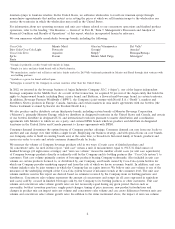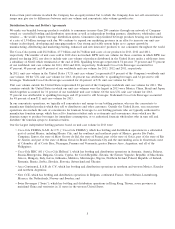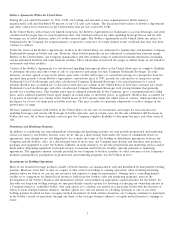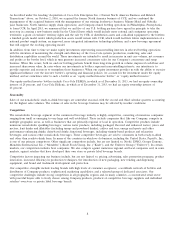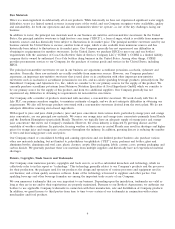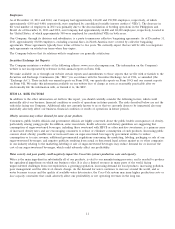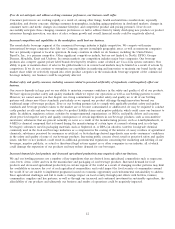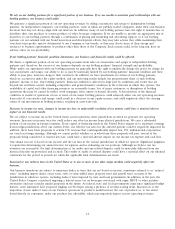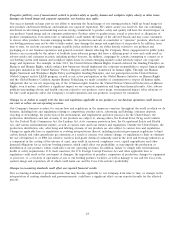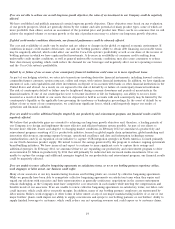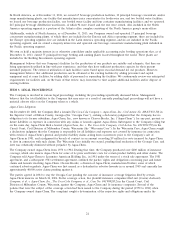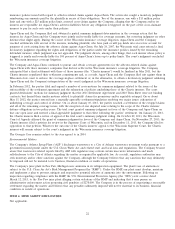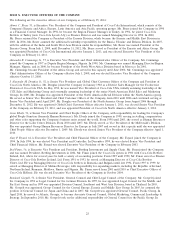Coca Cola 2013 Annual Report Download - page 15
Download and view the complete annual report
Please find page 15 of the 2013 Coca Cola annual report below. You can navigate through the pages in the report by either clicking on the pages listed below, or by using the keyword search tool below to find specific information within the annual report.Changes in the retail landscape or the loss of key retail or foodservice customers could adversely affect our financial performance.
Our industry is being affected by the trend toward consolidation in the retail channel, particularly in Europe and the United
States. Larger retailers may seek lower prices from us and our bottling partners, may demand increased marketing or promotional
expenditures, and may be more likely to use their distribution networks to introduce and develop private label brands, any of
which could negatively affect the Coca-Cola system’s profitability. In addition, in developed markets, discounters and value stores,
as well as the volume of transactions through e-commerce, are growing at a rapid pace. The nonalcoholic beverage retail
landscape is also very dynamic and constantly evolving in emerging and developing markets, where modern trade is growing at a
faster pace than traditional trade outlets. If we are unable to successfully adapt to the rapidly changing environment and retail
landscape, our share of sales, volume growth and overall financial results could be negatively affected. In addition, our success
depends in part on our ability to maintain good relationships with key retail and foodservice customers. The loss of one or more
of our key retail or foodservice customers could have an adverse effect on our financial performance.
If we are unable to expand our operations in emerging and developing markets, our growth rate could be negatively affected.
Our success depends in part on our ability to grow our business in emerging and developing markets, which in turn depends on
economic and political conditions in those markets and on our ability to acquire bottling operations in those markets or to form
strategic business alliances with local bottlers and to make necessary infrastructure enhancements to production facilities,
distribution networks, sales equipment and technology. Moreover, the supply of our products in emerging and developing markets
must match consumers’ demand for those products. Due to product price, limited purchasing power and cultural differences, there
can be no assurance that our products will be accepted in any particular emerging or developing market.
Fluctuations in foreign currency exchange rates could affect our financial results.
We earn revenues, pay expenses, own assets and incur liabilities in countries using currencies other than the U.S. dollar, including
the euro, the Japanese yen, the Brazilian real and the Mexican peso. In 2013, we used 80 functional currencies in addition to the
U.S. dollar and derived $27.0 billion of net operating revenues from operations outside the United States. Because our
consolidated financial statements are presented in U.S. dollars, we must translate revenues, income and expenses, as well as assets
and liabilities, into U.S. dollars at exchange rates in effect during or at the end of each reporting period. Therefore, increases or
decreases in the value of the U.S. dollar against other major currencies affect our net operating revenues, operating income and the
value of balance sheet items denominated in foreign currencies. In addition, unexpected and dramatic devaluations of currencies in
developing or emerging markets could negatively affect the value of our earnings from, and of the assets located in, those markets.
Because of the geographic diversity of our operations, weaknesses in some currencies might be offset by strengths in others over
time. We also use derivative financial instruments to further reduce our net exposure to currency exchange rate fluctuations.
However, we cannot assure you that fluctuations in foreign currency exchange rates, particularly the strengthening of the U.S. dollar
against major currencies or the currencies of large developing countries, would not materially affect our financial results.
If interest rates increase, our net income could be negatively affected.
We maintain levels of debt that we consider prudent based on our cash flows, interest coverage ratio and percentage of debt to
capital. We use debt financing to lower our cost of capital, which increases our return on shareowners’ equity. This exposes us to
adverse changes in interest rates. When and to the extent appropriate, we use derivative financial instruments to reduce our
exposure to interest rate risks. We cannot assure you, however, that our financial risk management program will be successful in
reducing the risks inherent in exposures to interest rate fluctuations. Our interest expense may also be affected by our credit
ratings. In assessing our credit strength, credit rating agencies consider our capital structure and financial policies as well as the
consolidated balance sheet and other financial information for the Company. In addition, some credit rating agencies also consider
financial information of certain of our major bottlers. It is our expectation that the credit rating agencies will continue using this
methodology. If our credit ratings were to be downgraded as a result of changes in our capital structure; our major bottlers’
financial performance; changes in the credit rating agencies’ methodology in assessing our credit strength; the credit agencies’
perception of the impact of credit market conditions on our or our major bottlers’ current or future financial performance and
financial condition; or for any other reason, our cost of borrowing could increase. Additionally, if the credit ratings of certain
bottlers in which we have equity method investments were to be downgraded, such bottlers’ interest expense could increase, which
would reduce our equity income.
13



